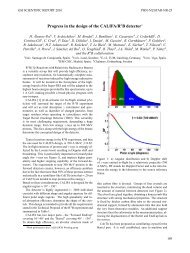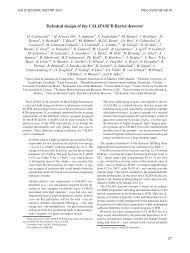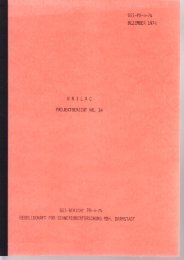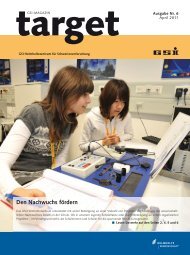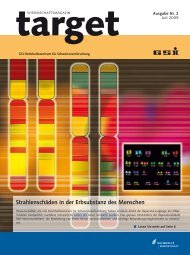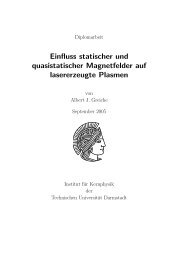download block - GSI Helmholtzzentrum für Schwerionenforschung
download block - GSI Helmholtzzentrum für Schwerionenforschung
download block - GSI Helmholtzzentrum für Schwerionenforschung
You also want an ePaper? Increase the reach of your titles
YUMPU automatically turns print PDFs into web optimized ePapers that Google loves.
ACC-OTHERS-05 <strong>GSI</strong> SCIENTIFIC REPORT 2009<br />
<strong>GSI</strong>Temp late2007<br />
High Voltage Pulse Generator for an ExB Chopper System*<br />
C. Wiesner # , L. P. Chau, H. Dinter, M. Droba, N. Joshi, O. Meusel, I. Müller and U. Ratzinger<br />
Institut <strong>für</strong> Angewandte Physik, Goethe-Universität, Frankfurt/Main, Germany;<br />
Introduction<br />
High intensity beams which are increasingly needed for<br />
a variety of applications pose new challenges for beam<br />
chopping. Long drifts must be avoided due to space<br />
charge constraints. The duty cycle for electrostatic beam<br />
deflection must be minimized in order to reduce the risk<br />
of voltage breakdowns. Beam dumping outside the transport<br />
line is preferable in order to avoid high power deposition<br />
and uncontrolled production of secondary particles<br />
at the slit or other vulnerable beamline components.<br />
ExB Chopper System<br />
An ExB chopper system for intense proton beams of up<br />
to 200 mA and repetition rates of up to 250 kHz is under<br />
development at IAP. It will be tested and installed in the<br />
low energy section of the Frankfurt Neutron Source<br />
FRANZ [1] with beam energies of 120 keV.<br />
Figure 1: Scheme of the ExB Chopper System.<br />
The chopper consists of a Wien filter-type ExB configuration,<br />
where the electric field can be pulsed and is<br />
followed by a static septum magnet [2]. As pulsing of the<br />
magnetic deflection field is not possible with a repetition<br />
rate of 250 kHz due to high power consumption, a pulsed<br />
electric field (fig. 3) is generated between two deflector<br />
plates located inside the dipole gap. It compensates the<br />
magnetic deflection and is thus creating a 100 ns proton<br />
pulse in forward direction for injection into the first accelerator<br />
structure.<br />
High Voltage Pulse Generator<br />
The electric field will be driven by a High Voltage<br />
Pulse Generator shown in fig. 2. It uses fast MOSFET<br />
* Work supported by BMBF – 06FY9089I and LOEWE-<br />
HIC for FAIR.<br />
# wiesner@iap.uni-frankfurt.de<br />
164<br />
technology in the primary circuit while the high voltage is<br />
provided in the secondary circuit around a ferrite transformer<br />
core.<br />
Figure 2: High Voltage Pulse Generator.<br />
Two pulses of more than 5 kV of positive and negative<br />
voltage, respectively, are required to charge both deflector<br />
plates symmetrically. Voltage pulses of ±5.8 kV with a<br />
repetition rate of 250 kHz were achieved (fig. 3). In addition<br />
post-pulse oscillations were minimized by reducing<br />
parasitic capacitances and by installing diodes as well as<br />
ohmic resistances.<br />
Figure 3: Measured Voltage Pulses.<br />
References<br />
[1] O. Meusel et al., “Injector Development for High<br />
Intensity Proton Beams at Stern-Gerlach-Zentrum”,<br />
LINAC’08, Victoria, BC, Canada, September 2008,<br />
MOP002, p. 49-51.<br />
[2] C. Wiesner et al., “Chopper for Intense Proton Beams<br />
at Repetition Rates up to 250 kHz”, PAC’09, Vancouver,<br />
BC, Canada, May 2009, TU6PFP088.





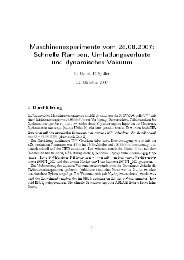
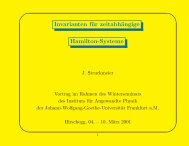
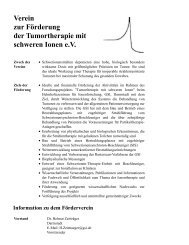
![GS I -P-]-17 - GSI Helmholtzzentrum für Schwerionenforschung](https://img.yumpu.com/20698964/1/184x260/gs-i-p-17-gsi-helmholtzzentrum-fur-schwerionenforschung.jpg?quality=85)

